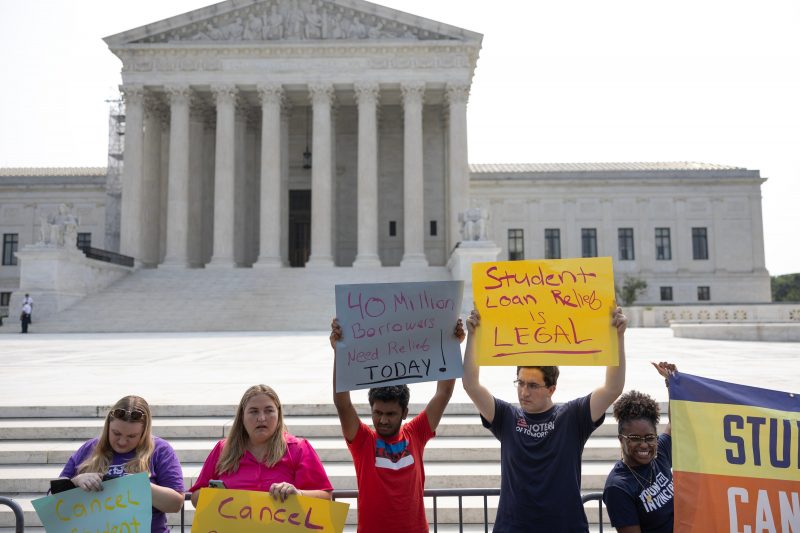Aaron Satyanarayana was disheartened by the recent Supreme Court ruling against affirmative action. His girlfriend Maxine Ewing is worried about the fallout from the court’s decision to block President Biden’s plan to forgive student loan debt.
And Cam Kuhn was livid that a majority of the justices sided with a website designer who refused services to LGBTQ+ people on religious grounds.
The trio of young voters plans to make their objections known at the ballot box next year, viewing the court’s actions as out of step with the issues and values important to them and their peers.
For many voters under 35 years of age, especially those on the left, the Supreme Court has become a political issue in the same way that climate change, gun violence and immigration have over the course of the last two decades, some political scientists and organizers have said.
Conversations with more than a dozen young voters from around the country who recently visited Washington for the nation’s 247′s birthday celebration suggest a sense of frustration, even resignation for some, but also a renewed understanding that their votes directly impact which justices sit on the federal bench.
Democrats and liberals have viewed the high court as an institution that has historically protected the rights of marginalized groups. But Republican politicians and activists on the right have successfully remade the court to reflect conservative values: former president Donald Trump, back by a Republican Senate, appointed three justices to the court, creating a 6-3 conservative majority.
Over the past five years, trust in the United States Supreme Court to “do the right thing” all or most of the time has decreased by 10 percentage points among 18- to 29-year-olds, according to a 2023 national poll released by the Institute of Politics at Harvard Kennedy School.
The court’s rulings this term, along with last year’s decision striking down Roe v. Wade that guaranteed the right to abortion, could prompt more young people to be active in next year’s presidential and congressional elections, some observers predict.
“They are [angry] because government continues to give them the short end of the stick, they’re going to turn out and vote. And in this case, it could not be more clear that there’s two sides and the contrast could not be more stark,” said Antonio Arellano, a spokesman for NextGen America.
Some, like Satyanarayana, 24, who recently moved to D.C. from New York, say this moment calls for more than just casting a ballot.
“It’s not the time to kind of isolate or dissociate from reality or the work that has to be done in political and social movements,” Satyanarayana said. ‘And as somebody who has been so averse towards door-knocking and canvassing my entire life, these three decisions and Dobbs are shifting my mindset.” Dobbs v Jackson Women’s Health Organization, was the court case on which the court decided last year that there was no constitutional right to abortion.
Ewing, 24, who is from New York, generally shies away from political debates but had much to say about the court’s decision to block Biden’s plan to forgive up to $20,000 in debt for student loan borrowers.
“They are setting up a generation and future generations for failure, and it’s gonna impact everyone,” Ewing said as she and Satyanarayana stood on a shaded stretch of grass on the National Mall. “What’s gonna happen when none of us can buy houses? What’s gonna happen when none of us can buy anything?”
Young voters, who overwhelmingly supported Democratic candidates in last year’s midterms, were credited with helping to stop an anticipated Republican tsunami in Congress. Democrats were able to hold onto the Senate and the GOP won the House with only a slim majority. A Washington Post analysis of census turnout data indicates that 26 percent of voters under 30 turned out in 2022, which was down from 2018, but still notably higher than any midterm election between 2002 and 2014.
And in the spring, college-aged voters in Wisconsin headed to the polls in droves to elect Janet Protasiewicz, flipping the Wisconsin Supreme Court’s majority from conservative to liberal, in a bid to protect abortion rights in the state. Additionally, the state’s young voter turnout led the nation in November’s midterm elections, according to data from the U.S. Census Bureau.
Still, turnout among young voters continues to lag behind older voters. Rick Hasen, UCLA Professor of Law and Political Science and Director of the Safeguarding Democracy Project, said organizers should seek to expand the number of young people on the voter rolls.
“The kind of political action that should be targeted at young people, the very first thing to think about even more than getting people to show up at the polls is getting them to register in the first place,’ Hasen said.
In addition to its rulings against affirmative action and student loan forgiveness, the court’s ruling that a Colorado graphic artist could refuse to creat wedding websites for same-sex couples, citing her religious objections.
Kuhn, 34, identifies as a member of the LGBTQ+ community. He said he vividly remembers the day the court guaranteed marriage rights for LGBTQ couples. He cites the 2015 Obergefeld v Hodges decision, as the moment he started to pay attention to the Supreme Court. “I felt so supported by my country,” he said. Now, almost a decade later, Kuhn struggles to grapple with what he describes as the Supreme Court’s “swing in the other direction.”
“I want to believe that the Supreme Court is not political, but it’s very hard,” Kuhn said. “I think what everybody is feeling right now is we’re tired of the government telling us how we should live our lives. Let us have our freedoms, let us love who we want to love, let us go to college where we want to go to college, let people have their reproductive rights.”
Kuhn, who lives in Little Rock, Ark., said he hopes to join organizing efforts for LGBTQ issues and student loan forgiveness ahead of next year’s elecgtion. Although Kuhn would like to see newer leaders in the Democratic Party run for president, such as Michigan Gov. Gretchen Whitmer or California Gov. Gavin Newsome, he plans to support Biden in the 2024. “He is the right person, especially with us potentially facing Trump coming back,” Kuhn added.
Christian Blanks has always described himself as conservative. But, as he and his mother, Bari, paused in front of the Supreme Court recently to grab a photo, they both expressed their doubts about the Republican Party’s ability to capture their vote in the 2024 election cycle.
Blanks’ sister is transgender and, in their home state of Louisiana, has spent most of her life under attack. Just this year, amid sweeping changes to laws governing diversity and inclusion programs in schools and access to abortion, Louisiana legislators made repeated efforts to ban gender-affirming medical care for young transgender people and sought to enact a “Don’t Say Gay” bill barring discussions about gender and sexuality in schools.
“I used to be kind of a conservative first, but then after all of these, you know, kind of bible-pumping, senators and candidates have come about, I just, you know, I’ve definitely become more on the left,” Christian said.
His mother thinks the Supreme Court, which for decades was seen as protecting the rights of marginalized groups, is now “influenced by career politicians.”
“Aside from the fact that the country is more polarized than it’s ever been, I think the right-leaning GOP and the infringement on the right to privacy and personal rights is deplorable,” Bari Blanks said.
But Christian added that Democrats would need to put forward better options to earn his vote in 2024. “If it’s just really primarily going to be Joe Biden versus one of the radical right-leaning candidates running, I’m not even gonna bother, because where I vote in Louisiana, it’s always conservative folks that win.”
According to a 2023 survey by Marist Poll, 50% of 18 to 29-year-old voters disapprove of the job Joe Biden is doing as president. The poll also found that 61 percent of young people don’t want former president Donald Trump to return to the Oval Office.
Voters under 30, who backed Biden by a wide margin ccording to exit polls conducted by Edison Research and AP VoteCast, were hopeful that the Democrat would make good on his promise to protect abortion access, cancel student loan debt and defend the rights of LGBTQ+ individuals. But a series of Supreme Court decisions have made those goals seemingly unachievable. Many now see voting for Biden as a matter of survival.
“I felt like after Roe v. Wade, it just went downhill from there. And I feel like that was the starting point of like, really seeing how bad things could get,” said 21-year-old Faye Ipaye, a student at Bowie State University. “I feel like young people don’t have a lot of trust in them… We’re gonna like have to just pick the lesser of the two evils. I’m just like about doing my due diligence.”
Organizations like NextGen America, a liberal advocacy group and political action committee, are trying to make sure that disillusionment doesn’t turn into disengagement. Its mission is to increase national voter turnout on college campuses and among voters ages 18-29 years old. Through social media outreach, organizers educate about voting resources and Supreme Court rulings and their impact through trusted messengers and peers who can communicate the stakes of the decisions.
Although young voters have consistently leaned Democratic, the party shouldn’t take that support for granted, organizers warn.
Clarissa Unger, CEO of Students Learn Students Vote Coalition, a nonpartisan voter education network working to increase turnout among college students, said Gen-Z voters don’t bind themselves to parties but instead respond to candidates who demonstrate an understanding of their lived experience. ‘Both parties have an opportunity to make a direct appeal to young people and to bring them into the fold and I think it’s to either party’s detriment to not do so,” Unger added.
A study by the Tufts’ Center for Information & Research on Civic Learning and Engagement (CIRCLE) estimated 8.3 million youth became eligible voters in 2022, with 46 percent representing communities of color. If mobilized, this diverse group of newly eligible voters brings with them a unique set of policy priorities shaped by identity and informed by significant national struggles like confronting the covid-19 pandemic and the social justice movement that grew around the police killing of George Floyd, said Kei Kawashima-Ginsberg, Newhouse Director of CIRCLE.
According to data from The Education Data Initiative over 15 million millennials have student loan debt, owing more to the government than any other generation. On average, the group carries a balance of $33,173 per borrower with many waiting, with fingers crossed, for the passage of Joe Biden’s loan forgiveness agenda.
For student borrowers like Estefani Marchena, 21, a senior at the University of North Carolina Greensboro said when she took out the loans, she didn’t think ahead to how muc it might cost to pay them back. “I have loans, but I’m just like, I’ll figure it out later when I graduate,” she said. Marchena said that she never knew much about Biden’s loan forgiveness plan, and did not imagine a possibility in which it would happen. But now she thinks it could have been a helpful resource.
Marchena hopes to attend graduate school next year, pursuing a master’s degree in public health. She wants to make healthcare resoures more accessible for minorities and people with disabilities. “I think there’s still a lot of change that needs to be made,” she said.
Come 2024, she is certain she will make her way to the polls to cast a ballot for Joe Biden, bringing her boyfriend, Chase in tow. Marchena said she voted for Biden in 2020 because it was “the lesser of two evils.” In an ideal world, she said, her candidate of choice was Bernie Sanders. ‘You have to be smart. I think, slowly, you have to make change to get more Democratic people in office,” she said.



























